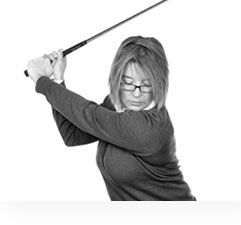 Natalie Adams – PGA Teaching Pro
Natalie Adams – PGA Teaching Pro
There are several different methods used to swing a golf club correctly in the modern day of golf. And what we’re going to look at with this swing tip is the one-plane swing method, and the positives and the negatives with this swing method. So just basically a one-plane swing means that you’re just swinging the club back at one angle as it rises on the backswing, and then it drops on exactly the same angle as it moves onto the downswing. So really mechanically it’s a very, very simple movement, there’s very little to go wrong with it.
We can demonstrate that quite easily, here we just set up a range basket with an alignment pole just coming out of the range basket at about 45 degree angle to the floor. If you don’t stand if you’re a right handed golfer to the left of this by about a meter or so, and set up and ready to hit your golf shot so that where the club head is, is in line with where the alignment pole is coming out of the ground. You can use this pole to indicate if you’re swinging on a one-plane swing.
So one-plane swing would see the club head moving backwards just over the alignment pole, so that your left arm also finishes parallel to the alignment pole and then it’s going to come back down just above the alignment pole and into the ball. So this swing really, really uses your body a lot to generate all the power. There’s no adjustment coming from the arms and the hands so mechanically it’s just very straight forward it’s very simple, it’s just up and down on one line.
So it’s a great way to have a consistent swing with not a lot of room for error. However, on the negative side of it this type of swing characteristically suits players where we see quite a forward inclined in their spine angle or posture. So that would be a type of player who really leans forward. Now it’s not going to suit me at all because of my height. With being slightly shorter I’m going to want to try and get as much height as I cannot posture even though I am tilted forward.
So really this type of swing wouldn’t suit me, I’d be much better using a two-plane method where I’m going to be more based on tempo and timing on my downswing, as I have to use my arms and hands to drop the club onto the correct plane. However, if you are slightly taller person and you can get more of the inclined posture setup, and start to develop a lower hand position this is going to allow you to swing back just have a slightly steeper inclining your shoulders okay.
And as that happens your body will rotate and just produce a slightly flatter angle with your left arm, and then you’ll just be able to turn your body back into the shot and generate all the power with your body turn. But similarly if you’re player who struggles a little bit with flexibility a one swing plane wouldn’t necessarily suit you because you’re generating all of your power from your core strength and you flexibility. So there are positives and negatives to using the one-plane method, try out though and see whether it’s a one-plane, two-plane or maybe a tilt and stack swing plane that would suit you most.





